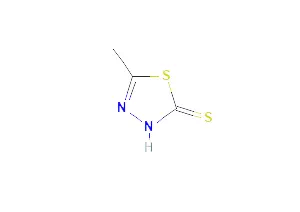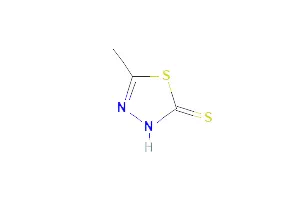All Categories


2-Mercapto-5-Methyl-1,3,4-Thiadiazole, CAS 29490-19-5
2-mercapto-5-methyl-1,3, 4-thiadiazole appears as a pure white crystalline powder in appearance.
CAS : 29490-19-5
Formula : C3H4N2S2
Mol. wt. : 132.21
EINECS : 249-667-1
Chemical Name | 2-Mercapto-5-Methyl-1,3,4-Thiadiazole |
Other Name | Thiadiazole; 2-Mercapto-5-methyl-1,3,4-thiadiazole (MMTD), 99%; Methylmercaptothiadiazole MMTD |
CAS | 29490-19-5 |
EINECS | 249-667-1 |
Type | Food additives; Pharmaceutical raw materials; Organic raw materials |
Molecular Formula | C3H4N2S2 |
Molecular Weight | 132.21 |
In the field of chemistry, the name "thiadiazole" usually specifically refers to the compound 2-mercapto5-methyl-1,3, 4-thiadiazole. 2-mercapto-5-methyl-1,3, 4-thiadiazole appears as a pure white crystalline powder in appearance. It holds a crucial position in both the chemical industry and the medical field, especially in the process of synthesizing the antibiotic drug cefazolin sodium, where it plays a key role as an indispensable and important intermediate.
As for its existing preparation methods, they are mainly carried out using hydrazine hydrate, ethyl acetate, methanol or ethanol solvents, alkaline solutions, carbon disulfide, and acid solutions as raw materials. There are specific considerations and requirements in the selection of these raw materials. Among them, for the solvent part, methanol or ethanol is usually adopted. This is because they have some unique physical and chemical properties that can provide a suitable environment for the reaction. In terms of alkaline solutions, potassium hydroxide or liquid ammonia are generally chosen. These two alkaline solutions can play specific catalytic or regulatory roles during the reaction process, promoting the reaction to proceed in the expected direction. As for acid solutions, concentrated sulfuric acid or concentrated hydrochloric acid are commonly used, and they also play important roles in the reaction system. The entire preparation process is not a simple mixing reaction, but requires a series of complex and ordered steps, specifically including the hydration, addition, cyclization and hydrolysis of ethyl acetate, etc. Only in this way can the target product 2-thiol-5-methyl-1,3, 4-thiadiazole be obtained.
However, the existing preparation method is not perfect and it has many rather obvious shortcomings. First of all, excessively long reaction time is a prominent issue, which largely affects production efficiency and makes the entire production process lengthy and cumbersome. Secondly, high energy consumption is also a drawback that cannot be ignored. A large amount of energy consumption not only increases production costs but also exerts certain pressure on energy supply. Moreover, the operation process of this method is extremely complex and cumbersome, requiring strict operation procedures and condition control. This places high demands on the professional quality of the operators. A slight mistake may lead to reaction failure or poor product quality. In addition, the high production cost is also an important factor restricting its wide application. The accumulated expenses from raw material procurement to equipment maintenance, energy consumption and other links affect the price competitiveness of the product in the market. More crucially, during the production process, a large amount of waste and waste is easily generated. This not only imposes a significant pollution burden on the environment but also goes against the concept of sustainable development. At the same time, there are deficiencies in pollutant treatment, making it difficult to achieve the goal of green and environmentally friendly production.

Melting point | 185-188 °C |
Boiling point | 182.9±23.0 °C(Predicted) |
density | 1.373 (estimate) |
refractive index | 1.5500 (estimate) |
storage temp. | Sealed in dry,Room Temperature |
solubility | chloroform: soluble10mg/mL, clear to very slightly hazy, colorless |
form | solid |
pka | 6.49±0.40(Predicted) |
Water Solubility | 2 g/100 mL |
As a new type of powerful nitration inhibitor, 2-mercapto5-methyl-1,3, 4-thiadiazole (cefazolin EP) has demonstrated unique value and significance in the field of pharmaceutical chemistry. This compound has a specific chemical structure. The thiol group, methyl group and thiadiazole ring and other structural units in its molecule jointly endow it with special chemical properties and reactivity. It is also a key intermediate in the process of synthesizing thiazolyl acetylglycine oxime (t344230), playing an indispensable bridging role in complex organic synthetic routes and providing an important synthetic precursor for the further construction of target molecules with specific biological activities or pharmacological effects.
2-mercapto5-methyl-1,3, 4-thiadiazole, as a pharmaceutical intermediate, has a relatively wide range of applications. Researchers have conducted in-depth studies on the degradation effect of ultraviolet light (UV) and the combination of ultraviolet light and water (UV/h₂o) on this compound. During the experiment, by precisely controlling various experimental conditions, such as the intensity of ultraviolet rays, irradiation time, and the content of water in the system, etc., the degradation behavior and product changes of 2-thiol-5-methyl-1,3, 4-thiadiazole under different conditions were observed and analyzed in detail. These research results are of great significance for understanding the stability mechanism of the compound, optimizing storage and usage conditions, and also provide valuable reference basis for the research and development and quality control of related drugs.
It is worth mentioning that 2-mercapto5-methyl-1,3, 4-thiadiazole is also an important intermediate of the antibiotic cephalosporin V, especially playing a core role in the synthesis process of cefazolin sodium (Cephalosporin 5). Cefazolin sodium, as a commonly used antibiotic in clinical practice, has a good therapeutic effect on various bacterial infections. And 2-mercapto-5-methyl-1,3, 4-thiadiazole, as its intermediate, its quality and purity are directly related to the safety and efficacy of the final drug product. Therefore, the research on the preparation process, quality standards and stability of this intermediate has always been a key focus in the field of pharmaceutical research and development, aiming to ensure the efficient and stable production of high-quality cefazolin sodium drugs to meet the needs of clinical treatment.
* Prompt reply and 24 hours online, professional team to provide best price and high quality product.
* Sample testing support.
* Every batch of products will be tested to ensureits quality.
*The packing also can be according the customers` requirment.
*Any inquiries will be replied within 24 hours.
*we provide Commerical Invoice, Packing List, Bill of loading, COA , Health certificate and Origin certificate. If your markets have any special requirements, let us know.